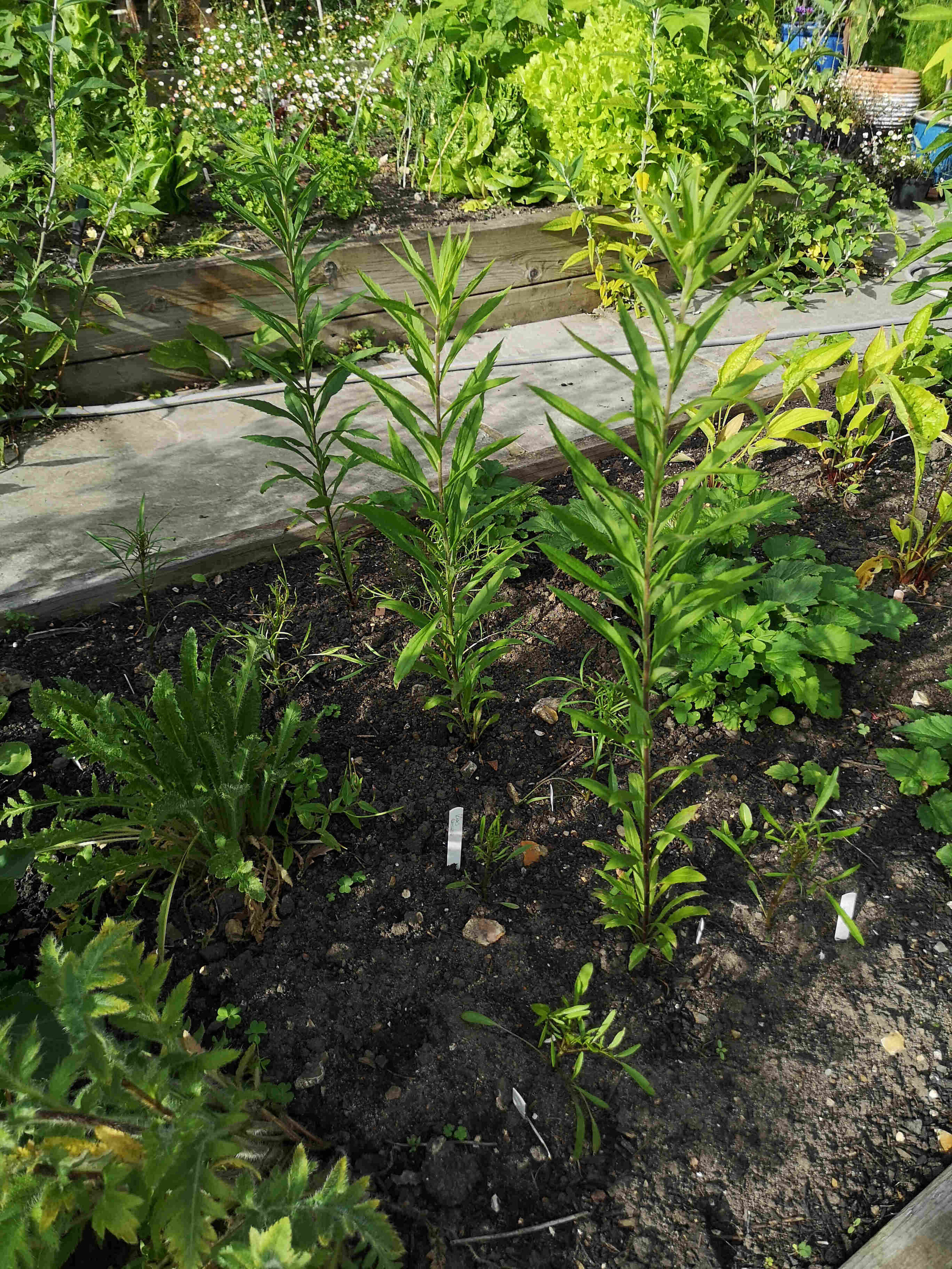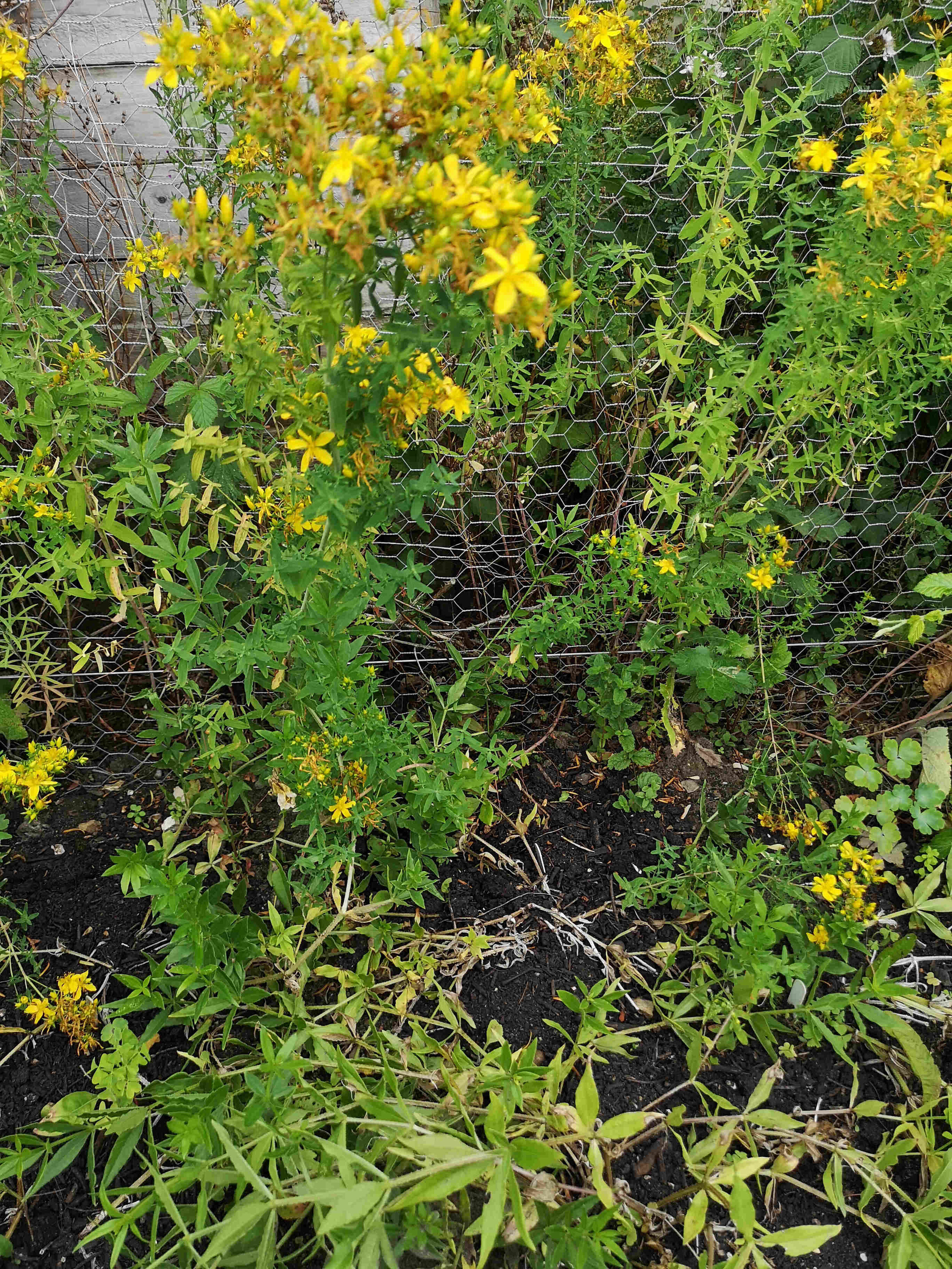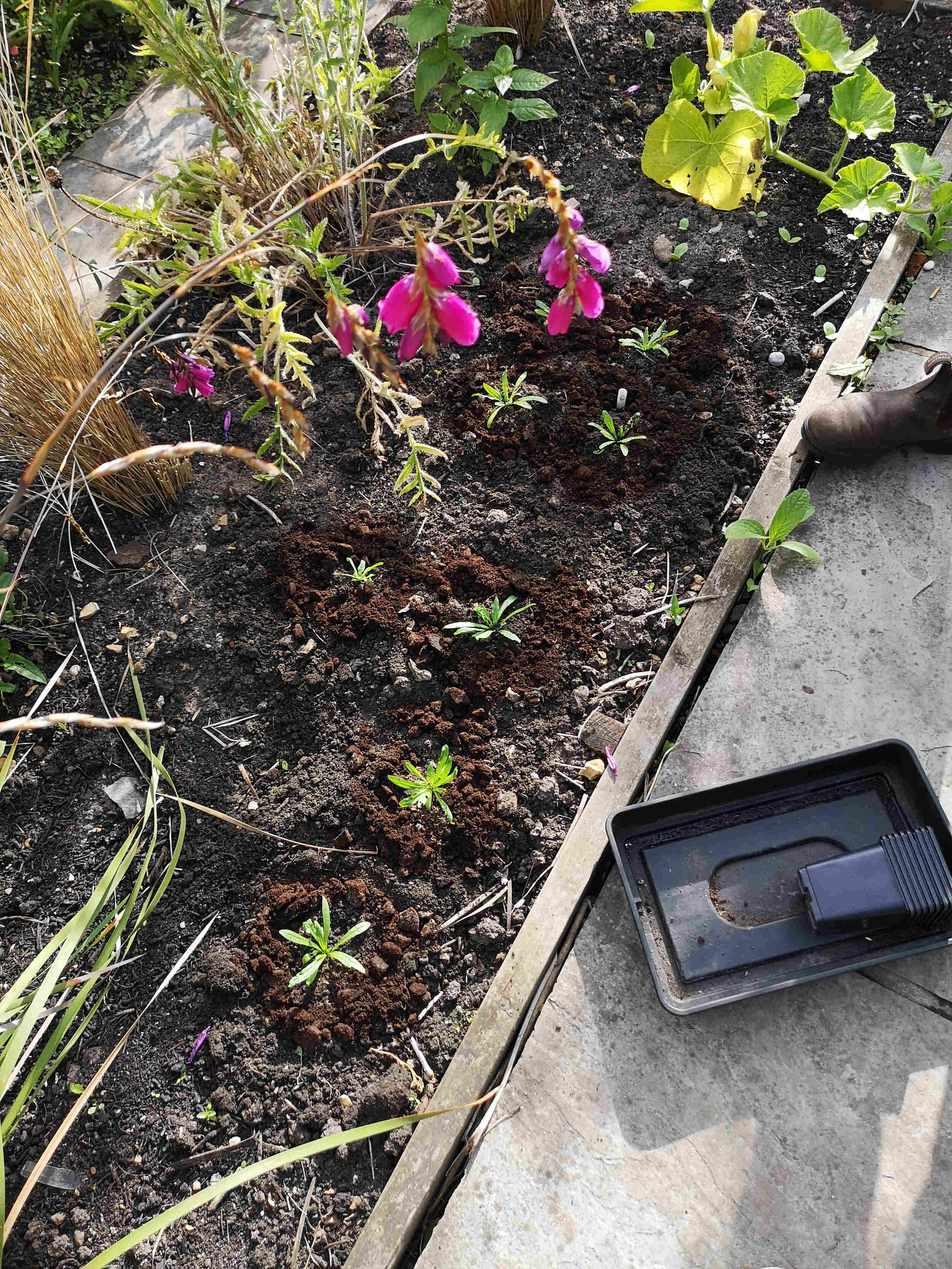High Summer in my Bristol Natural Dye Garden: July and August 2020
Somehow it’s September, Summer seems to have disappeared and it won’t. Stop. Raining.
My intentions to keep up with a monthly blog about my dye garden have seriously lapsed. I was convinced I’d written one in July, but all I managed was to create a photo album! So, here’s a bit of a whirlwind update about what’s been growing, what hasn’t been growing and what I’m planning next…
A quick trip to the ‘Surrey wing’ of the garden…
My first trip out of Bristol since lockdown was to my Mum’s house and beautiful garden near Farnham. She’s helped me grow seedlings, answered endless horticultural questions, and generously lent me some space in her productive garden.
Alongside cut flowers and vegetables, there is a bit of room for dye plants. I donated a tray full of weld seedlings, as I’ve completely run out of space. Most importantly, Mum is hosting beds of madder, planted annually to ensure a yearly crop. The first bed will be ready next Autumn.
An added bonus to my visit was discovering great swathes of St John’s Wort (Hypericum Perforatum) throughout the garden. I’d wanted to dye with the flowers for a while, as you can allegedly get 4 shades from one dye bath, if you follow the correct order. Here I was able to harvest enough to make a dye pot - I’ll blog about my experiences soon (maybe…)
L-R Goldenrod and Coreopsis, St John’s Wort (growing wild) and Madder, Weld seedlings
The Bristol dye garden - mid-July 2020
As I’ve said in previous posts, I’m about a month behind where I’d like to be this year, but I did manage to finally get everything in the ground in the hope for a long summer growing season.
The hollyhocks at the back bloomed wonderfully, however they were all pale pinks and peach colours. Gorgeous to look at, but no good for dyeing! But, the bees have loved them and they have really complemented the darker dahlias in front, and given some height to the garden.
The weather has been interesting - this ‘Summer’ has included storms with hideous wind and rain, and super hot dry spells. Not great growing conditions, and the slugs and snails are rampant!
August - the Dye Garden in Bloom
Heading into a new month with a good spell of sunshine and occasional rain really helped the garden come to life!
I have two containers of Madder that are entering their thrid year. It flowered, and is starting to set seed. Once thats over, I’m going to harvest the roots. I have no idea what to expect, but I hope the three year wait is worth it and I get some good red dye out of them. To be honest, I’ll be happy to see the back of them - I am pretty allergic to the plant and keep scratching my legs on the spiky tendrils!
Dotted around the main flowerbed are 11 Hopi sunflowers, the seeds of which make a purple dye. I include these seeds in my bundle dye kit as they make amazingly vibrant marks on the knitted cloth. They’ve grown to varying heights and sizes, depending on where they’ve been placed in the garden. This was a deliberate experiment and I now know where to plant a patch next year (near the compost bin, behind the shed). They really took a beating in the storms we had in late August, but luckily they’ve all survived.
Although most of the hollyhocks were a disappointing pink and peach, there was one bright pink plant, of whose blooms I have been saving ready for the dye pot.
I’ve been growing red basil on the windowsill in the home office - last year we tried planting some into the ground but the climate was far too variable for it. As it started to bolt and flower, I cut the plants back and used to dye yarn for my Summer Yarn Club a wonderful mauve shade.
L-R: Madder in flower, Hopi sunflower, Hollyhock, Red Basil
My singular St John’s Wort plant provided a few flowers, which have been dried and used in the bundle dye kits, whereas the plant tops were cut back and used for dye. I got a really lovely soft orange shade which I wasn’t expecting. It’s nestled in underneath a hop plant, which for the first year has finally produced some hops! These are grown for a co-operative project with a local brewery, hopefully they will be brewing this year as I will be so pleased to finally contribute!
The Dahlias that I relocated at the start of spring are absolutely loving their new position and producing plenty of blooms and leaves. Most of the flowers are red and orange like last year, but I have one plant that can’t decide if it’s yellow or orange! Either way, they produce a great dye and will go into my next batch of dye kits, later in the year.
The Marigolds have been constantly flowering despite several slug attacks. It’s my first year growing these cheery blooms, and I’m yet to dye properly with them, but I know they bundle dye really well. The bees love them too, and they’re a good crop for small pots that don’t take up too much space.
L-R: St John’s Wort, two-toned Dahlia, bee on a Marigold flower
Growing the Blues
My first foray into growing Japanese Indigo has been a real success - I sacrificed my sunniest bed for this new plant, and it’s really thrived. I’ve made several cuttings from this bed, experimenting with the salt rub and ice blender method, and even extracted pigment! I’ll write a blog shortly about my experience so far dyeing blue with this amazing plant. The cut stems root in water quickly, so I’ve donated them to other growers in the hope we can work towards having a Bristol Blue! How amazing would that be?
Meanwhile at the front of the house, the new bed we built for Woad is doing it’s job nicely. I do occasionally forget to water it in hot weather, but the plants are pretty hardy and healthy, as I made sure to feed them when the bed was first planted. I will take some cuttings from this shortly, and possibly make a small vat with the leaves. Neighbourhood pigeons have taken quite a shine to the leaves, so I need to harvest soon before they’re all gone!
Harvesting
While my Coreopsis plants are lagging behind (they moved beds this year to make way for the Indigo), the Dahlias and Cosmos are regularly doing their thing. I’m short on yarn to dye, so while I wait for the mill to deliver my next batch, I’m drying everything. I tried freezing some flowers last year, which is a great temporary solution, but I’ve found they don’t store for too long and the potency of the colour seems to dwindle after a few months.
L-R: Dahlia flowers and leaves, Dyer’s Chamomile Flowers, Coreopsis and Cosmos flowers
Thinking ahead to future summers, all of the Weld seedlings I could fit into a bed are having a great time of it. This is the first time I’ve managed to get any to germinate, and so far the cats have stayed off which helped the plants establish. Next year they’ll shoot up huge flower stems, a sign that they are ready to harvest for the best source of yellow dye (in my opinion).
While my own Hollyhocks were the wrong colour, my in-laws garden was full of the dark purple variety. As well as kindly saving and drying the flowers for me, my mother-in-law gave me some cuttings to take seed from, meaning I’ll have the correct colour in two years time (Hollyhocks are a biennial). Seed-saving is such an important part of sustainable gardening, I made sure to take as many as I could to pass on at seed swaps or with dyer friends.
The Hopi sunflowers are slowly fading and drooping. I’ve been told to leave them to try on the stem as much as possible to ensure the seeds develop. I had one casualty in the recent storm, which I’ve let dry and shaken out the seeds. I’ve found a standard kitchen sieve works as a great seed sorter for these larger seeds. Don’t the empty flowerheads look amazing?
L-R: Hollyhock seeds, Weld plants, Hopi sunflower head and seeds
Current View - Wet and Windswept!
September has been wet and windy so far, and doesn’t show much sign of improving just yet. I’m hoping we’ll get a warm patch (as we often do later in September) to help my plants be more productive for a bit longer.
Last year I was harvesting flowers all the way into October, only preparing the beds for winter in November, so I’m optimistically hopeful…
The challenges of this year reiterate a point I quite often say - that I dye with the seasons, and that the colour palette of my designs depend on what’s growing this year. Expect less oranges from Coreopsis and more Yellows from Chamomile and Weld. Perhaps this year, there will be some touches of blue from my indigo patch, too.
Planning ahead, I’ve realised I need to try and scale my growing up a little. Workshops and kits have proved popular, and I have to keep up with demand for my knitwear too. I’ve set a goal to be 100% self-sufficient with the dyes I use by the end of next year, meaning I won’t buy any in. To make this feasible, I must make room for more growing space.
One way I am going to do this is by redesigning the ‘main’ garden bed (to the right) next year, removing shrubs and a couple of ornamentals. Of course I’m on the waiting list for an allotment, but it will probably be at least a decade until it’s my turn! A friend has offered me a bit of space on her allotment, and another is growing some Woad and Coreopsis for me. The potential to scale up is certainly there, I just need to work out how I will have the time to do everything!
If you’ve enjoyed reading this blog and found it helpful, why not buy me a virtual coffee on Ko-Fi? There’s no obligation, but your support will help me continue to write these blogs and help me continue my journey to becoming a self-sufficient natural dye grower and knitwear designer. Ria :)





















